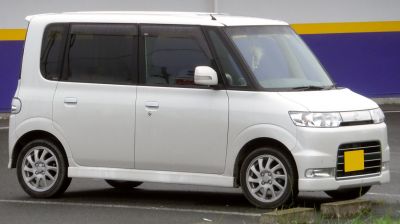 1998 Mitsubishi Toppo (BJ) Dimensions, Size & Specs
1998 Mitsubishi Toppo (BJ) Dimensions, Size & Specs
Measurements of the 1998 Mitsubishi Toppo, engineered for optimal performance and comfort
| Dimensions | |
|---|---|
| Length: | 3395 mm133.7 in11.1 ft |
| Width: | 1475 mm58.1 in4.8 ft |
| Height: | 1740 mm68.5 in5.7 ft |
| Weight Specifications | |
| Curb Weight: | 790-840 kg1742-1852 lbs |
| Maximal permitted Weight: | 1010-1060 kg2227-2337 lbs |
| Tire Specifications | |
| Tire Sizes: |
|
The Mitsubishi Toppo (BJ) generation is a compact minivan produced from 2000 to 2004, originally introduced in 1998. This model stands out for its uniquely tall, boxy design aimed at maximizing interior space within a very compact footprint. Measuring just 3395 mm (133.7 inches) in length and 1475 mm (58.1 inches) in width, the Toppo is designed primarily for urban environments where maneuverability and parking ease are crucial. It uses its height of 1740 mm (68.5 inches) effectively, offering ample headroom and a spacious, airy cabin despite its small platform.
The vehicle's curb weight ranges between 790 to 840 kg (1742 to 1852 lbs), reinforcing its light and nimble character. The maximum allowable weight ranges from 1010 to 1060 kg (2227 to 2337 lbs), ensuring efficient performance and fuel economy. Mitsubishi equipped the Toppo with tire sizes of 145/80 R13 and 165/60 R14 to balance ride comfort and stability on city roads.
Overall, the Mitsubishi Toppo (BJ) is an excellent example of a kei-class minivan, excelling in space efficiency and practicality without sacrificing maneuverability. It suits drivers who need a versatile urban vehicle, offering a clever use of vertical space that differentiates it from other small cars and minivans on the market in its production period. Whether for city commuting or small family transport, the Toppo combines lightweight construction with a tall, compact silhouette to create a truly functional and economical vehicle.
Discover the standout features that make the 1998 Mitsubishi Toppo a leader in its class
Have a question? Please check our knowledgebase first.
The Mitsubishi Toppo (BJ) from 2000 to 2004 has a compact exterior footprint ideal for urban driving and parking. Its length measures 3395 mm (133.7 inches), making it easy to maneuver in tight city spaces. The width is 1475 mm (58.1 inches), which contributes to its narrow profile, helpful in congested roads and narrow lanes. Standing tall at 1740 mm (68.5 inches), the vehicle offers a spacious interior height for passengers despite its compact base. These dimensions classify it well within the Kei car or micro-minivan segment.
The curb weight of the Mitsubishi Toppo (BJ) ranges between 790 to 840 kg (1742 to 1852 lbs), while its maximum weight capacity spans 1010 to 1060 kg (2227 to 2337 lbs). This relatively lightweight construction aids in improving fuel efficiency and nimbleness in city driving conditions. The modest curb weight also means less strain on the engine and braking systems, allowing for efficient handling and lower running costs. Its lightweight nature is characteristic of minivans designed for short-distance and urban use.
Yes, the Mitsubishi Toppo (BJ) fits comfortably into a standard residential garage. With its length of 3395 mm (133.7 inches), width of 1475 mm (58.1 inches), and height of 1740 mm (68.5 inches), it occupies less space than a typical mid-size vehicle. Standard garages usually have door widths around 2400 mm (94.5 inches) and heights over 2000 mm (78.7 inches), giving ample clearance for the Toppo. Its narrow width and moderate height ensure easy access and parking without requiring special garage modifications.
Despite its compact exterior dimensions, the Mitsubishi Toppo (BJ) effectively utilizes its tall height of 1740 mm (68.5 inches) to provide spacious headroom and comfortable seating for passengers. Typically configured as a minivan, it offers flexible seating arrangements to maximize interior utility within the relatively short 3395 mm (133.7 inches) length. The compact width of 1475 mm (58.1 inches) limits shoulder space but the boxy design maximizes usable interior volume, making it suitable for city families or small groups requiring versatile seating and cargo configurations.
The Mitsubishi Toppo (BJ) utilizes tire sizes 145/80 R13 or 165/60 R14, both designed to complement its lightweight and compact nature. The 145/80 R13 tires feature a higher aspect ratio, offering increased sidewall height which improves ride comfort by absorbing bumps and road irregularities effectively. The alternative 165/60 R14 tires have a wider width and lower profile that enhances handling responsiveness and corner grip, which benefits stability during turns and higher speed driving. Both tire options balance economy, comfort, and handling suitable for urban use.
Compared to its predecessor, the Mitsubishi Toppo (BJ) introduced between 2000-2004 maintains a similarly compact footprint but often features slight refinements for better interior space utilization and external proportions. While the earlier generation may have had marginally different dimensions, the BJ generation hones in on maximizing vertical space (height at 1740 mm or 68.5 inches) and efficient overall length (3395 mm or 133.7 inches) to offer a taller and more usable cabin. Width remains narrow at 1475 mm (58.1 inches), consistent with its kei and microvan heritage.
The Mitsubishi Toppo (BJ) competes closely with other Japanese micro or kei minivans such as the Suzuki Wagon R, Daihatsu Move, and Honda Life. Dimensionally, it is on par with these vehicles, featuring a length of 3395 mm (133.7 in), width of 1475 mm (58.1 in), and a tall height of 1740 mm (68.5 in) which is common in this category to maximize interior space. Its relatively light weight (790-840 kg) also helps with fuel economy. While some competitors might offer variations in engine tuning or interior features, the Toppo’s size is competitive for urban maneuverability and compact family usage.
The Mitsubishi Toppo (BJ)’s cargo capacity is designed to be flexible within its compact dimensions. Typically, its rear seats can be folded flat or partially to expand cargo space significantly in this minivan configuration. While exact cargo volume figures are sparse, the vehicle's tall height (1740 mm / 68.5 in) allows for vertical stacking, optimizing usable space. This feature makes it practical for transporting goods or luggage in an urban environment without significantly increasing vehicle length or footprint.
Yes, the Mitsubishi Toppo (BJ) is suitable for small urban families looking for an economical, easy-to-park minivan. Weighing between 790 to 840 kg (1742 to 1852 lbs), it offers nimble handling in city conditions and consumes less fuel. While its compact width (1475 mm / 58.1 in) limits shoulder space, the tall height (1740 mm / 68.5 in) and flexible seating provide ample vertical room for passengers and cargo. It's a practical choice for short to medium commutes, grocery runs, and everyday city errands, especially where parking space is limited.
During its production from 2000 to 2004, the Mitsubishi Toppo (BJ) was favored for its compact size, efficient design, and urban practicality. It was commonly used as a city car or small family minivan due to its easy maneuverability and economical weight of 790 to 840 kg (1742 to 1852 lbs). Features included a tall roofline for better headroom, practical seating configurations, and compact footprint for tight city environments. Its performance and dimensions made it ideal for short-distance travel, light cargo, and parking in congested urban areas where space was at a premium.
Discover similar sized cars.

| Production: | 2003-2007 |
|---|---|
| Model Year: | 2004 |
| Length: | 3395 mm133.7 in |
| Width: | 1475 mm58.1 in |
| Height: | 1725 mm67.9 in |
